Effect of Chlorides Content on the Structure and Properties of Porous Glass Ceramics Obtained from Siliceous Rock
Abstract
:1. Introduction
- To employ thermal analysis (TA) and X-ray diffraction (XRD) to define the effect of additives on phase transformations in the charge mixture during heating and the phase composition of annealed porous glass ceramics;
- To reveal the effect of additives in the charge mixture composition on the macro- and microstructure of porous glass ceramics;
- To determine the effect of the content of NaCl, KCl, MgCl2·6H2O, and CaCl2 in the charge mixture composition on the physico-mechanical and thermophysical properties, as well as chemical stability of porous glass ceramics samples.
2. Materials and Methods
2.1. Materials
- Siliceous rock of the following chemical composition was used: SiO2—67.86%; CaO—7.74%; Al2O3—7.61%; Fe2O3—1.99%; K2O—1.56%; MgO—1.07%; TiO2—0.34%; Na2O—0.17%; P2O5—0.15%; SO3—0.06%; SrO—0.06%; BaO—0.02%; ZrO2—0.01%; V2O5—0.01%; MnO—0.01%; Cr2O3—0.01%; LOI—11.32%. The rock’s mineralogical composition: cristobalite—20.5%; heulandite—20.4%; quartz—15.5%; calcite—10.5%; muscovite—13.1%; amorphous phase—20.0%. The siliceous rock was dried to a moisture content of <1%.
- Sodium carbonate (Na2CO3) was used to reduce the melting point and foaming of the charge mixture. The purity was ≥99%.
- To obtain an even macrostructure of pores in glass ceramics, chlorides and their crystallohydrates were used as additives: NaCl, KCl, MgCl2·6H2O, CaCl2. The purity was ≥97%.
2.2. Compositions and Fabrication Technology of Samples
- Mechanochemical activation of raw materials. Siliceous rock, sodium carbonate and additives were being grinded in a planetary ball mill Retsch PM 400 for 35 min (overload inside the crushing cylinder—20G). The required concentration of components was determined by us on the basis of preliminary tests, as well as by the results of previous works [17]. The charge mixture compositions are presented in Table 1.
- Annealing. The charge mixture obtained after mechanochemical activation was put into metal molds with a size of 120 mm × 120 mm × 260 mm and annealed in a muffle furnace (the molds were previously coated with clay). Annealing schedule: heating to a temperature of 670 °C at a rate of 4.5 °C/min, holding at a temperature of 670 °C for 1 h, heating to a temperature of 850 °C at a rate of 4.5 °C/min, holding at a temperature of 850° C for 30 min; cooling to room temperature inside the furnace.
- Preparation of samples for testing. The molds with the resulting material were removed from the furnace and dismantled. The resulting porous glass ceramics were sawn into samples of the required sizes and tested.
2.3. Analytical Techniques
2.3.1. X-ray Diffraction (XRD)
2.3.2. Thermal Analysis (TA)
2.3.3. Scanning Electron Microscopy (SEM)
2.3.4. Apparent Density and Porosity
2.3.5. Bending and Compressive Strength
2.3.6. Thermal Conductivity
2.3.7. Thermal Shock Resistance
2.3.8. Limiting Operating Temperature
2.3.9. Chemical Stability
3. Results and Discussion
3.1. Charge Mixture’s TA
3.2. Grass Ceramics Samples’ XRD
3.3. Porous Glass Ceramics Macrostructure
3.4. SEM Micrographs of Samples
3.5. Apparent Density and Porosity of Samples
3.6. Strength of Samples
3.7. Thermal Conductivity of Samples
3.8. Thermal Shock Resistance
3.9. Limiting Operating Temperature
3.10. Chemical Stability
4. Conclusions
- A small amount of chloride produces a significant effect on the phase transformations in the charge mixture obtained from siliceous rock. The increase in the amount of additive in the charge mixture to 0.368% has accelerated the formation of sodium silicates and decreased the calcite’s decarbonization temperature. The peak of the exothermic effect shifted to higher temperatures by ≤40 °C.
- Samples of glass ceramics with a uniform fine-porous structure from siliceous rock with a calcite content (10.5%) have been obtained by modifying the charge mixture with chlorides (NaCl, KCl, MgCl2·6H2O and CaCl2) in the amount of 0.096 to 0.368%. The pore diameter in the material decreased to ≈0.5 mm after the increase in the amount of additive. Glass ceramic samples consist of quartz, wollastonite, devitrite, anorthoclase and amorphous phase. The additives used (chlorides) have a negligible effect on the phase composition of the samples.
- The developed porous glass ceramic has an apparent density of 245–267 kg/m3; bending and compressive strength up to 1.75 MPa and 3.8 MPa, respectively; thermal conductivity 0.065–0.068 W/(m∙°C); thermal shock resistance 170–180 °C; limiting operating temperature up to 860 °C; and high chemical stability.
- Comparing some indicators, the obtained materials are superior to foam glass and other analogues. They can be used as thermal insulation for some types of industrial and civil facilities.
Author Contributions
Funding
Institutional Review Board Statement
Informed Consent Statement
Data Availability Statement
Conflicts of Interest
References
- Fernandes, H.R.; Tulyaganov, D.U.; Ferreira, J.M.F. Preparation and characterization of foams from sheet glass and fly ash using carbonates as foaming agents. Ceram. Int. 2009, 35, 229–235. [Google Scholar] [CrossRef]
- Zhu, M.; Ji, R.; Li, Z.; Wang, H.; Liu, L.; Zhang, Z. Preparation of glass ceramic foams for thermal insulation applications from coal fly ash and waste glass. Constr. Build. Mater. 2016, 112, 398–405. [Google Scholar] [CrossRef]
- Guo, H.; Ye, F.; Li, W.; Song, X.; Xie, G. Preparation and characterization of foamed microporous mullite ceramics based on kyanite. Ceram. Int. 2015, 41, 14645–14651. [Google Scholar] [CrossRef]
- König, J.; Lopez-Gil, A.; Cimavilla-Roman, P.; Rodriguez-Perez, M.A.; Petersen, R.R.; Østergaard, M.B.; Iversen, N.; Yue, Y.; Spreitzer, M. Synthesis and properties of open- and closed-porous foamed glass with a low density. Constr. Build. Mater. 2020, 247, 118574. [Google Scholar] [CrossRef]
- Hisham, N.A.N.; Zaid, M.H.M.; Aziz, S.H.A.; Muhammad, F.D. Comparison of foam glass-ceramics with different composition derived from ark clamshell (ACS) and soda lime silica (SLS) glass bottles sintered at various temperatures. Materials 2021, 14, 570. [Google Scholar] [CrossRef] [PubMed]
- Kyaw Oo D’Amore, G.; Caniato, M.; Travan, A.; Turco, G.; Marsich, L.; Ferluga, A.; Schmid, C. Innovative thermal and acoustic insulation foam from recycled waste glass powder. J. Clean. Prod. 2017, 165, 1306–1315. [Google Scholar] [CrossRef]
- Cao, J.; Lu, J.; Jiang, L.; Wang, Z. Sinterability, microstructure and compressive strength of porous glass-ceramics from metallurgical silicon slag and waste glass. Ceram. Int. 2016, 42, 10079–10084. [Google Scholar] [CrossRef]
- Romero, A.R.; Toniolo, N.; Boccaccini, A.R.; Bernardo, E. Glass-ceramic foams from ‘weak alkali activation’ and gel-casting of waste glass/fly ash mixtures. Materials 2019, 12, 588. [Google Scholar] [CrossRef] [Green Version]
- Zeng, L.; Sun, H.; Peng, T.; Zheng, W. Preparation of porous glass-ceramics from coal fly ash and asbestos tailings by high-temperature pore-forming. Waste Manag. 2020, 106, 184–192. [Google Scholar] [CrossRef]
- Ivanov, K.S. Optimization of the structure and properties of foam-glass ceramics. Mag. Civ. Eng. 2019, 89, 52–60. [Google Scholar]
- Kazantseva, L.K.; Rashchenko, S.V. Optimization of porous heat-insulating ceramics manufacturing from zeolitic rocks. Ceram. Int. 2016, 42, 19250–19256. [Google Scholar] [CrossRef]
- Yatsenko, E.A.; Goltsman, B.M.; Klimova, L.V.; Yatsenko, L.A. Peculiarities of foam glass synthesis from natural silica-containing raw materials. J. Therm. Anal. Calorim. 2020, 142, 119–127. [Google Scholar] [CrossRef]
- Huo, W.; Yan, S.; Wu, J.-M.; Liu, J.; Chen, Y.; Qu, Y.; Tang, X.; Yang, J. A novel fabrication method for glass foams with small pore size and controllable pore structure. J. Am. Ceram. Soc. 2017, 100, 5502–5511. [Google Scholar] [CrossRef]
- Ding, L.; Ning, W.; Wang, Q.; Shi, D.; Luo, L. Preparation and characterization of glass-ceramic foams from blast furnace slag and waste glass. Mater. Lett. 2015, 141, 327–329. [Google Scholar] [CrossRef]
- König, J.; Petersen, R.R.; Iversen, N.; Yue, Y. Application of foaming agent–oxidizing agent couples to foamed-glass formation. J. Non-Cryst. Solids. 2021, 553, 120469. [Google Scholar] [CrossRef]
- Xi, C.; Zheng, F.; Xu, J.; Yang, W.; Peng, Y.; Li, Y.; Li, P.; Zhen, Q.; Bashir, S.; Liu, J.L. Preparation of glass-ceramic foams using extracted titanium tailing and glass waste as raw materials. Constr. Build. Mater. 2018, 190, 896–909. [Google Scholar] [CrossRef]
- Erofeev, V.; Rodin, A.; Bochkin, V.; Ermakov, A. The formation mechanism of the porous structure of glass ceramics from siliceous rock. Mag. Civ. Eng. 2020, 100, A6. [Google Scholar]
- Kruszewski, Ł.; Palchik, V.; Vapnik, Y.; Nowak, K.; Banasik, K.; Galuskina, I. Mineralogical, geochemical, and rock mechanic characteristics of zeolite-bearing rocks of the hatrurim basin, Israel. Minerals 2021, 11, 1062. [Google Scholar] [CrossRef]
- Kazantseva, L.K.; Lygina, T.Z.; Rashchenko, S.V.; Tsyplakov, D.S. Preparation of Sound-Insulating Lightweight Ceramics from Aluminosilicate Rocks with High CaCO3 Content. J. Am. Ceram. Soc. 2015, 98, 2047–2051. [Google Scholar] [CrossRef]
- Erofeev, V.T.; Rodin, A.I.; Bochkin, V.S.; Ermakov, A.A. Properties of porous glass ceramics based on siliceous rocks. Mag. Civ. Eng. 2021, 102, 10202. [Google Scholar]
- Erofeev, V.T.; Rodin, A.I.; Kravchuk, A.S.; Kaznacheev, S.V.; Zaharova, E.A. Biostable silicic rock-based glass ceramic foams. Mag. Civ. Eng. 2018, 84, 48–56. [Google Scholar]
- Dunstan, M.T.; Donat, F.; Bork, A.H.; Grey, C.P.; Müller, C.R. CO2 Capture at Medium to High Temperature Using Solid Oxide-Based Sorbents: Fundamental Aspects, Mechanistic Insights, and Recent Advances. Chem. Rev. 2021, 121, 12681–12745. [Google Scholar] [CrossRef] [PubMed]
- Wieczorek-ciurowa, K.; Paulik, J.; Paulik, F. Influence of foreign materials upon the thermal decomposition of dolomite, calcite and magnesite part I. Influence of sodium chloride. Thermochim. Acta 1980, 38, 157–164. [Google Scholar] [CrossRef]
- Dal Pozzo, A.; Armutlulu, A.; Rekhtina, M.; Abdala, P.M.; Müller, C.R. CO2 Uptake and Cyclic Stability of MgO-Based CO2 Sorbents Promoted with Alkali Metal Nitrates and Their Eutectic Mixtures. ACS Appl. Energy Mater. 2019, 2, 1295–1307. [Google Scholar] [CrossRef]
- Qiao, Y.; Wang, J.; Zhang, Y.; Gao, W.; Harada, T.; Huang, L.; Hatton, T.A.; Wang, Q. Alkali Nitrates Molten Salt Modified Commercial MgO for Intermediate-Temperature CO2 Capture: Optimization of the Li/Na/K Ratio. Ind. Eng. Chem. Res. 2017, 56, 1509–1517. [Google Scholar] [CrossRef]
- Rekhtina, M.; Dal Pozzo, A.; Stoian, D.; Armutlulu, A.; Donat, F.; Blanco, M.V.; Wang, Z.J.; Willinger, M.G.; Fedorov, A.; Abdala, P.M.; et al. Effect of molten sodium nitrate on the decomposition pathways of hydrated magnesium hydroxycarbonate to magnesium oxide probed by in situ total scattering. Nanoscale 2020, 12, 16462–16473. [Google Scholar] [CrossRef]
- Chernykh, T.N.; Orlov, A.A.; Kramar, L.Y.; Trofimov, B.Y.; Perminov, A.V. Temperature reduction during brucite-based magnesia cement production. Mag. Civ. Eng. 2013, 38, 29–35. [Google Scholar] [CrossRef]
- Zhang, K.; Li, X.S.; Li, W.Z.; Rohatgi, A.; Duan, Y.; Singh, P.; Li, L.; King, D.L. Phase Transfer-Catalyzed Fast CO2 Absorption by MgO-Based Absorbents with High Cycling Capacity. Adv. Mater. Interfaces 2014, 1, 1400030. [Google Scholar] [CrossRef]
- Harada, T.; Simeon, F.; Hamad, E.Z.; Hatton, T.A. Alkali Metal Nitrate-Promoted High-Capacity MgO Adsorbents for Regenerable CO2 Capture at Moderate Temperatures. Chem. Mater. 2015, 27, 1943–1949. [Google Scholar] [CrossRef]
- Kazantseva, L.K.; Rashchenko, S.V. Chemical processes during energy-saving preparation of lightweight ceramics. J. Am. Ceram. Soc. 2014, 97, 1743–1749. [Google Scholar] [CrossRef]
- Almasri, K.A.; Sidek, H.A.A.; Matori, K.A.; Zaid, M.H.M. Effect of sintering temperature on physical, structural and optical properties of wollastonite based glass-ceramic derived from waste soda lime silica glasses. Results Phys. 2017, 7, 2242–2247. [Google Scholar] [CrossRef]
- Costa, F.P.D.; Morais, C.R.D.S.; Pinto, H.C.; Rodrigues, A.M. Microstructure and physico-mechanical properties of Al2O3-doped sustainable glass-ceramic foams. Mater. Chem. Phys. 2020, 256, 123612. [Google Scholar] [CrossRef]
- Türk, T.; Üçerler, Z.; Burat, F.; Bulut, G.; Kangal, M.O. Extraction of potassium from feldspar by roasting with CaCl2 obtained from the acidic leaching of wollastonite-calcite ore. Minerals 2021, 11, 1369. [Google Scholar] [CrossRef]
- Abdel-Hameed, S.A.M.; El-kheshen, A.A. Thermal and chemical properties of diopside-wollastonite glass-ceramics in the SiO2–CaO–MgO system from raw materials. Ceram. Int. 2013, 29, 265–269. [Google Scholar] [CrossRef]
- Montoya-Quesada, E.; Villaquirán-Caicedo, M.A.; Mejía de Gutiérrez, R.; Muñoz-Saldaña, J. Effect of ZnO content on the physical, mechanical and chemical properties of glass-ceramics in the CaO–SiO2–Al2O3 system. Ceram. Int. 2020, 46, 4322–4328. [Google Scholar] [CrossRef]
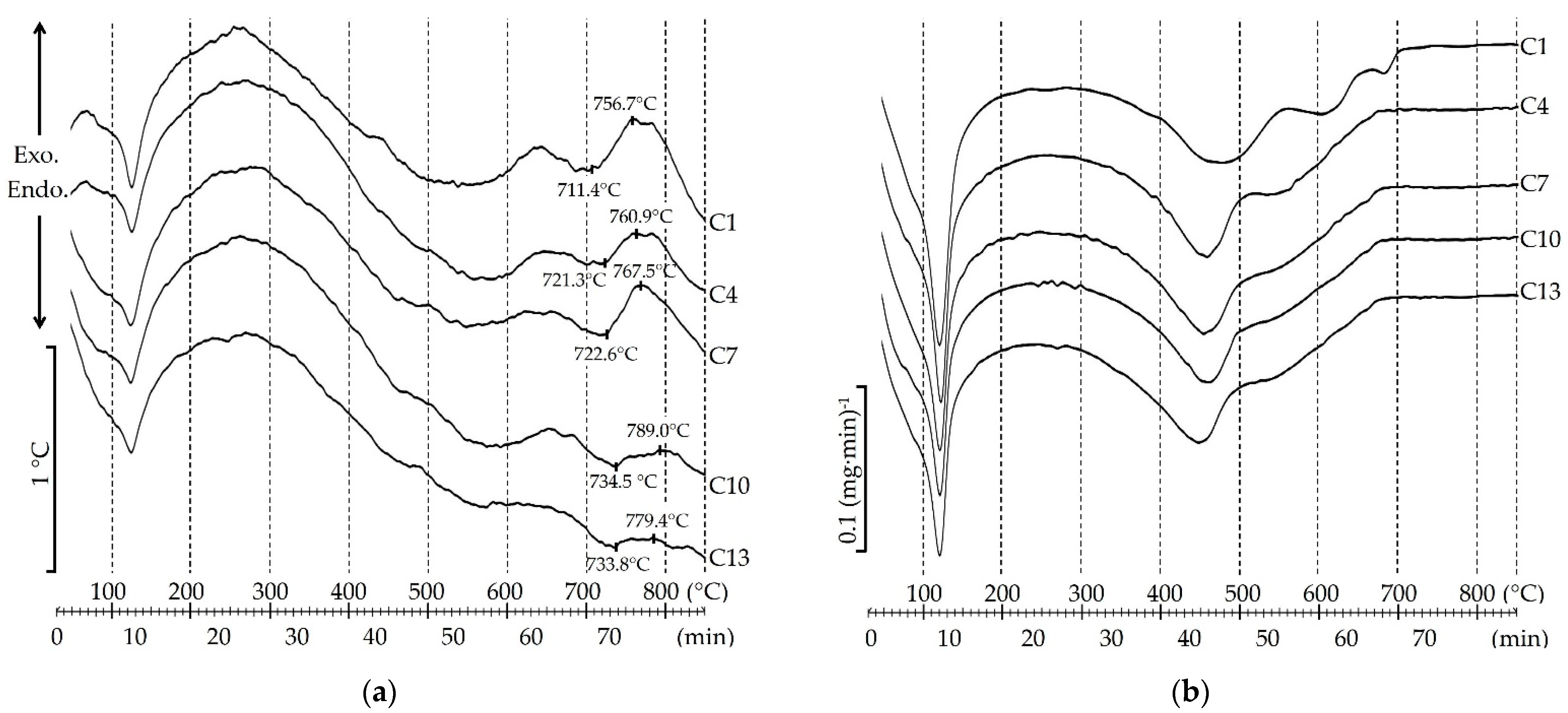


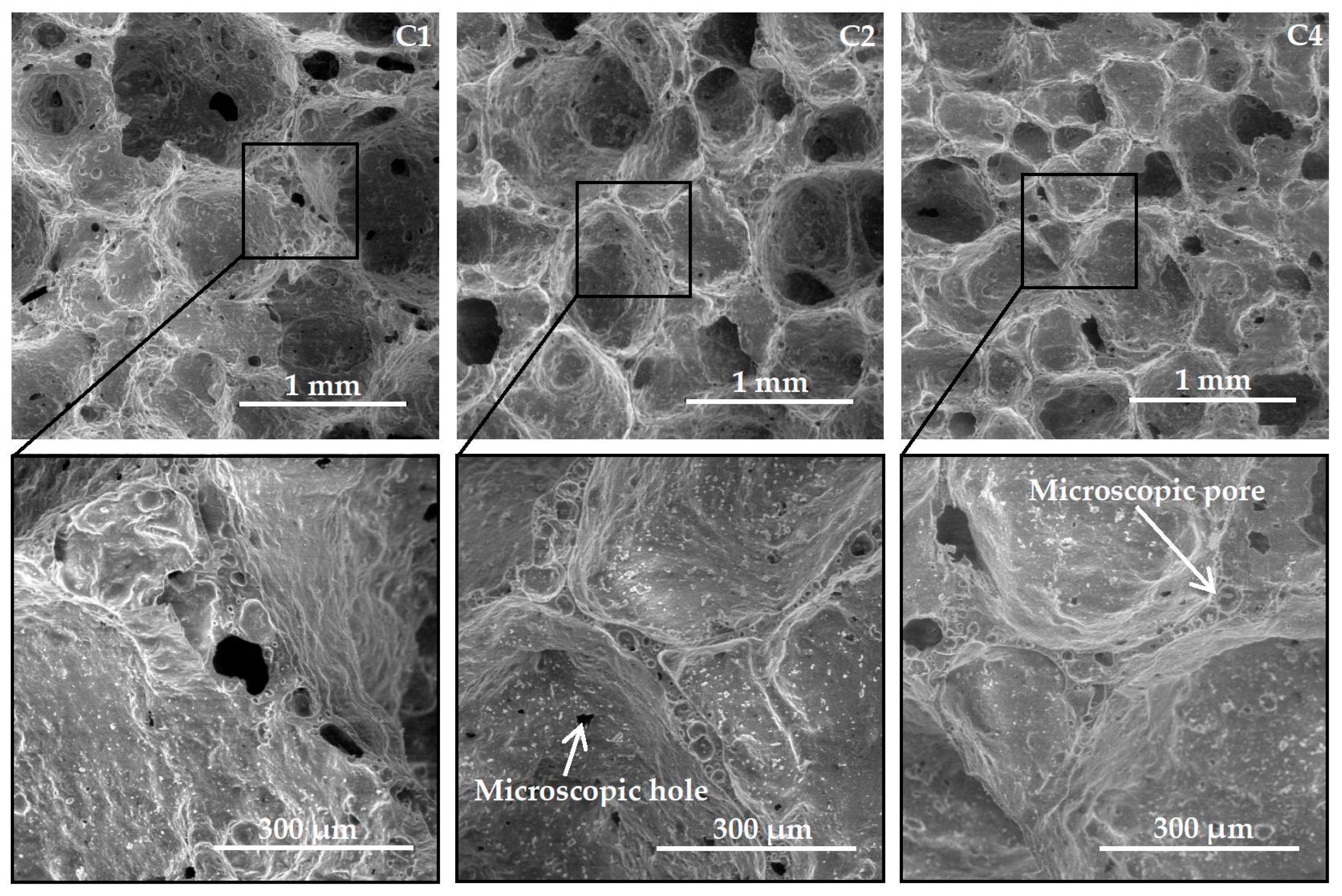
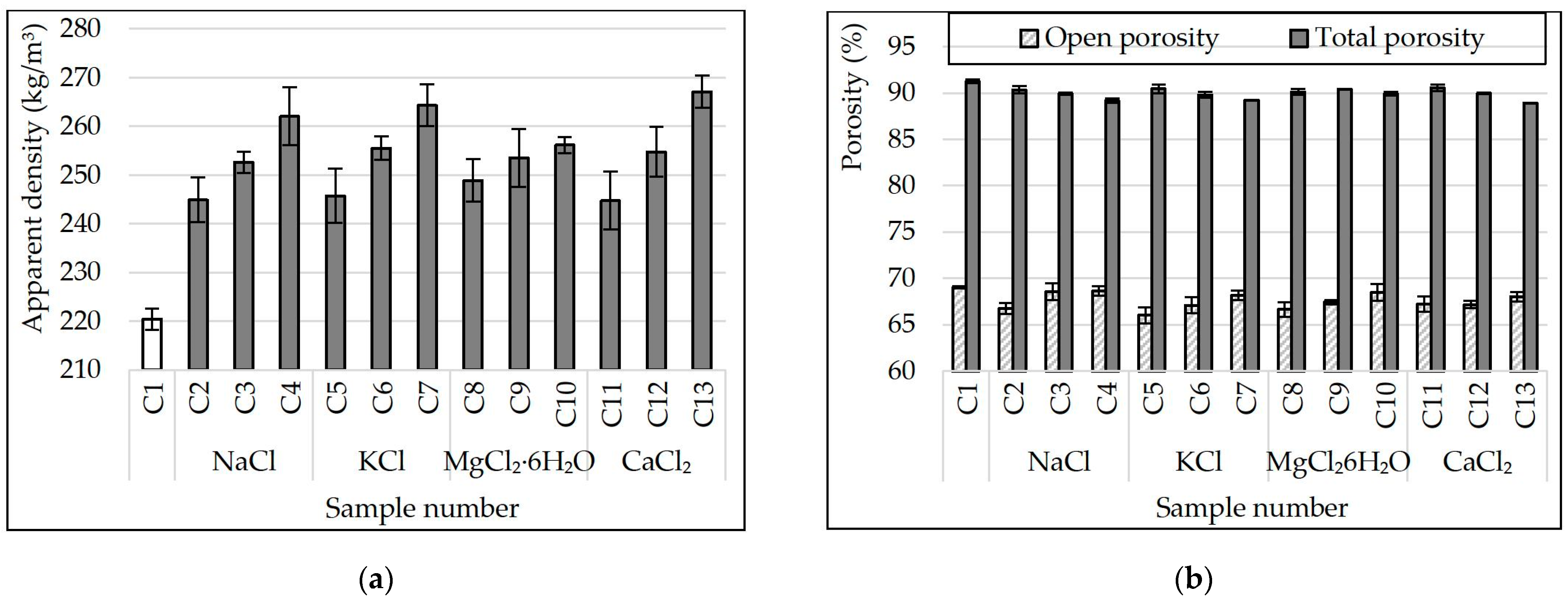

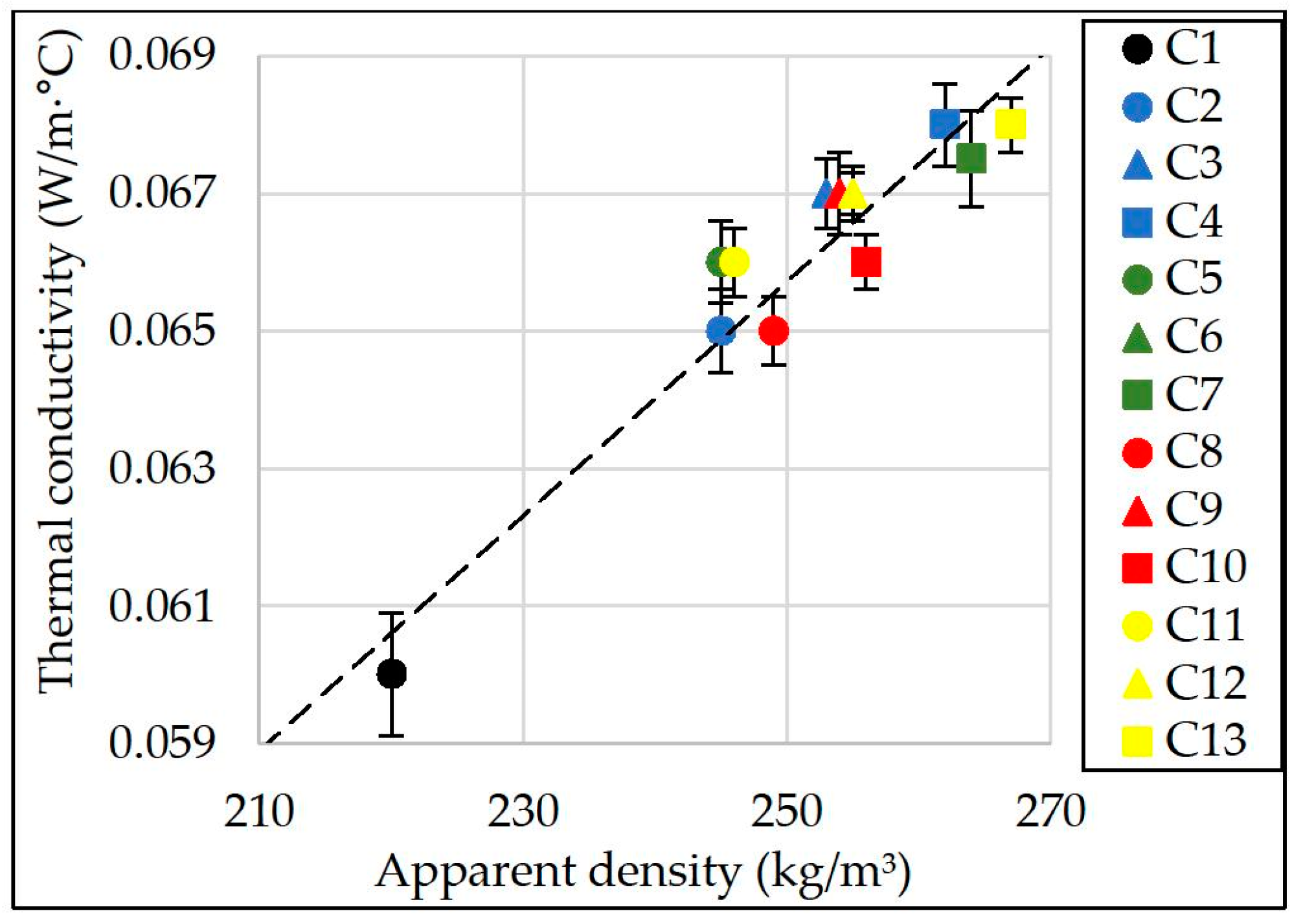
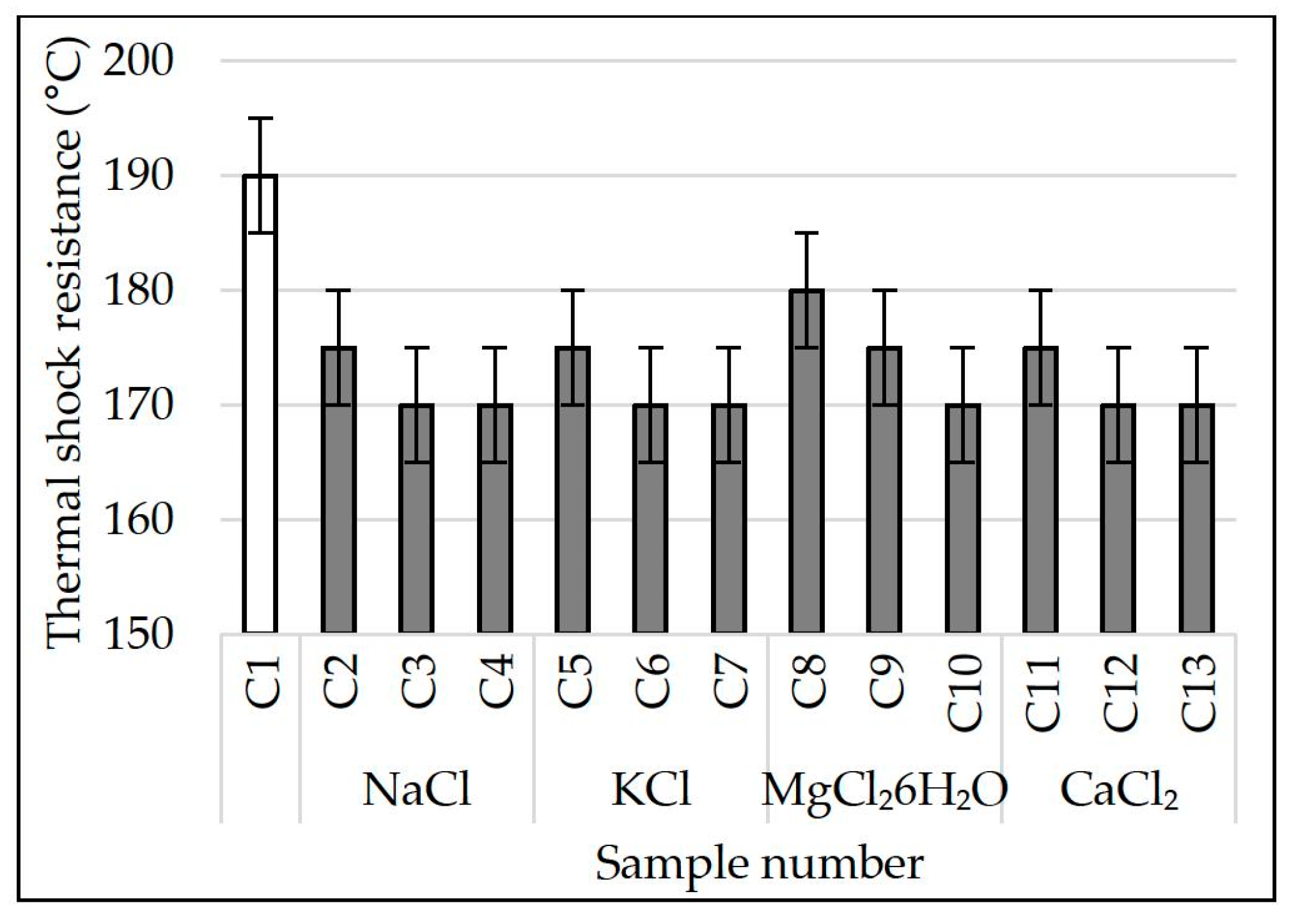
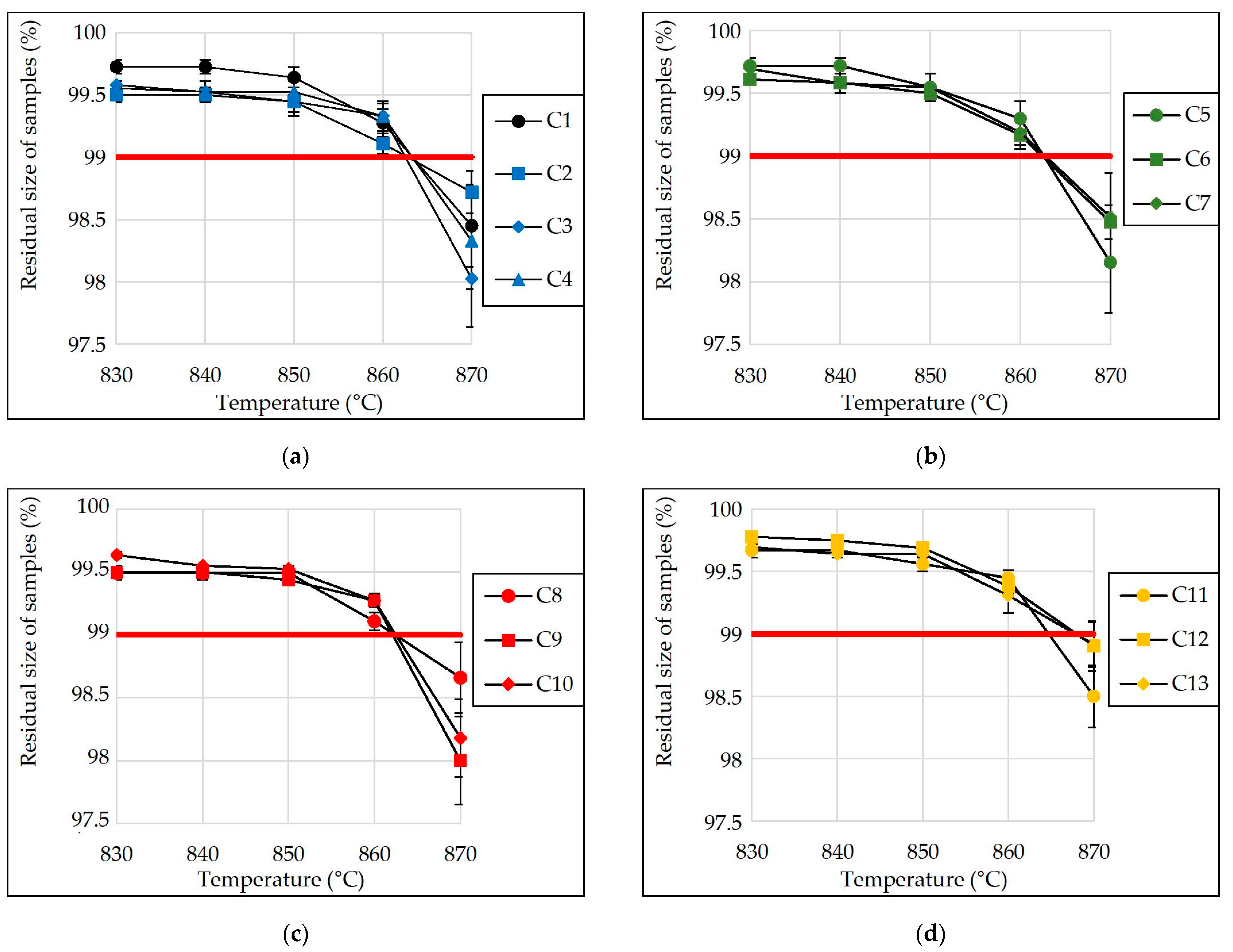
| No. of Composition | Charge Mixture’s Compositions, % | |||||
|---|---|---|---|---|---|---|
| Siliceous Rock | Na2CO3 | NaCl | KCl | MgCl2·6H2O | CaCl2 | |
| C1 | 81.6 | 18.4 | – | – | – | – |
| C2 | 18.308 | 0.092 | – | – | – | |
| C3 | 18.216 | 0.184 | – | – | – | |
| C4 | 18.032 | 0.368 | – | – | – | |
| C5 | 18.308 | – | 0.092 | – | – | |
| C6 | 18.216 | – | 0.184 | – | – | |
| C7 | 18.032 | – | 0.368 | – | – | |
| C8 | 18.308 | – | – | 0.092 | – | |
| C9 | 18.216 | – | – | 0.184 | – | |
| C10 | 18.032 | – | – | 0.368 | – | |
| C11 | 18.308 | – | – | – | 0.092 | |
| C12 | 18.216 | – | – | – | 0.184 | |
| C13 | 18.032 | – | – | – | 0.368 | |
| Composition No. | Change in the Samples’ Weight after Boiling in Chemical Media for 3 h, % * | ||
|---|---|---|---|
| H2O | 6 N HCl Solution | 1 N Na2CO3 Solution + 1 N NaOH Solution (1:1) | |
| C1 | 0.34 | 4.34 | 7.34 |
| C2 | 0.65 | 3.61 | 7.67 |
| C3 | 0.76 | 4.48 | 7.97 |
| C4 | 1.05 | 5.04 | 8.07 |
| C5 | 0.89 | 4.29 | 8.19 |
| C6 | 0.98 | 4.50 | 8.36 |
| C7 | 1.21 | 5.34 | 8.81 |
| C8 | 1.10 | 4.10 | 7.55 |
| C9 | 1.07 | 4.29 | 8.05 |
| C10 | 1.05 | 4.72 | 8.57 |
| C11 | 1.22 | 3.86 | 7.86 |
| C12 | 0.46 | 3.81 | 8.10 |
| C13 | 0.91 | 4.49 | 8.45 |
Publisher’s Note: MDPI stays neutral with regard to jurisdictional claims in published maps and institutional affiliations. |
© 2022 by the authors. Licensee MDPI, Basel, Switzerland. This article is an open access article distributed under the terms and conditions of the Creative Commons Attribution (CC BY) license (https://creativecommons.org/licenses/by/4.0/).
Share and Cite
Rodin, A.; Ermakov, A.; Erofeeva, I.; Erofeev, V. Effect of Chlorides Content on the Structure and Properties of Porous Glass Ceramics Obtained from Siliceous Rock. Materials 2022, 15, 3268. https://doi.org/10.3390/ma15093268
Rodin A, Ermakov A, Erofeeva I, Erofeev V. Effect of Chlorides Content on the Structure and Properties of Porous Glass Ceramics Obtained from Siliceous Rock. Materials. 2022; 15(9):3268. https://doi.org/10.3390/ma15093268
Chicago/Turabian StyleRodin, Alexander, Anatoly Ermakov, Irina Erofeeva, and Vladimir Erofeev. 2022. "Effect of Chlorides Content on the Structure and Properties of Porous Glass Ceramics Obtained from Siliceous Rock" Materials 15, no. 9: 3268. https://doi.org/10.3390/ma15093268
APA StyleRodin, A., Ermakov, A., Erofeeva, I., & Erofeev, V. (2022). Effect of Chlorides Content on the Structure and Properties of Porous Glass Ceramics Obtained from Siliceous Rock. Materials, 15(9), 3268. https://doi.org/10.3390/ma15093268









